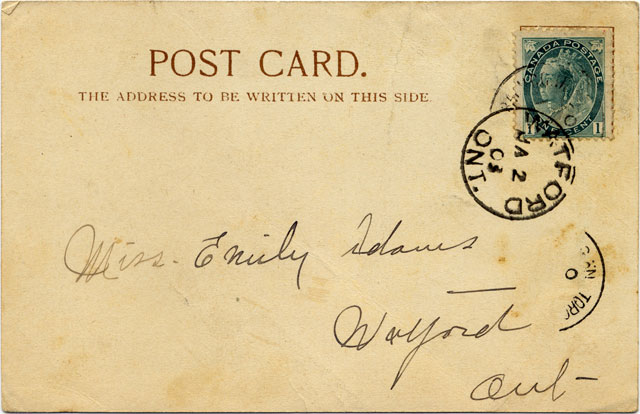This series of pioneer patriotic postcards, published by W.J. Gage & Co. Limited of Toronto, illustrated “The Soldiers of Canada in South Africa”. The series comprises ten cards, each available in white or khaki card stock.
Click on the image above for access to the collection.

“The Cause of it All”
Oom Paul Kuger
Registered cover to Milwaukee Wisconsin, USA from Toronto, with Toronto CDS dated March 28, 1901.
Published in 1900 by G.A. Lowe, a Toronto stamp dealer and postcard & cover publisher.
Cover bears two 2¢ Map stamps, two 2¢ QV Numerals and a 1¢ QV Numeral for an 11¢ rate.
Kenneth Rowe makes reference to this series in his “The Postal History of the Canadian Contingents, Anglo-Boer War, 1899–1902”. He notes this design was only published as a cover, but comes in both brown and blue ink, and with the vignette in two sizes: 30 mm x 25 mm and 62 mm x 50 mm.
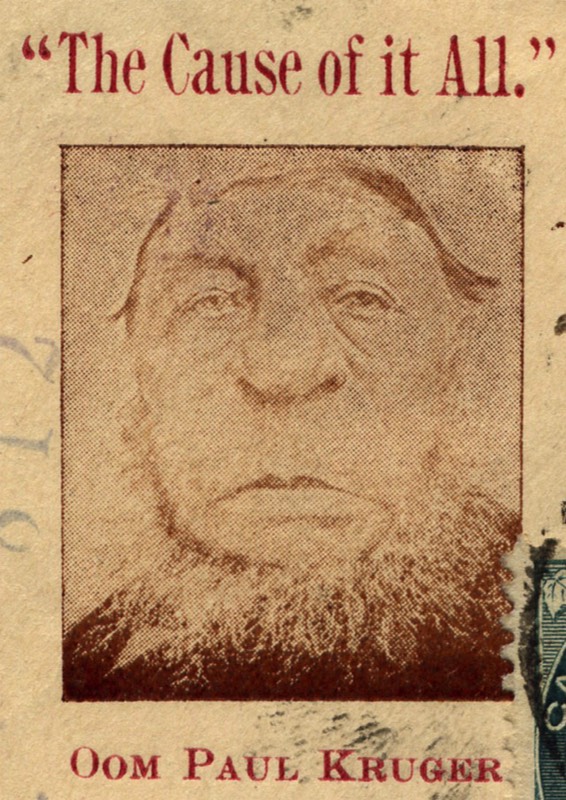
Above, a detail from the cover
Below, the publisher’s inscription

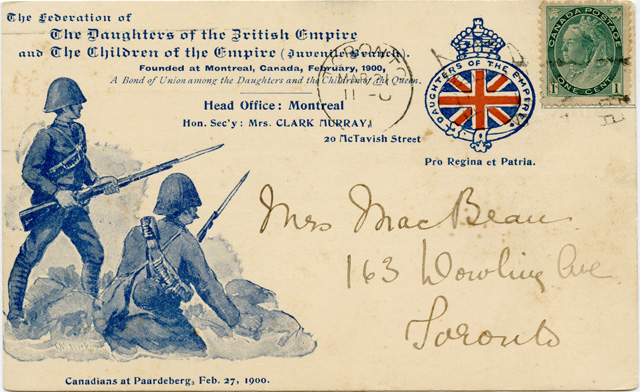
The Federation of
The Daughters of the British Empire
and The Children of the Empire (Juvenile Branch)
Founded at Montreal, Canada, February 1900
A Bond of Union among the Daughters and the CHildren of the Queen.
Head Office: Montreal
Hon. Sec’y: Mrs. Clark Murray
20 McTavish Street
Pro Regina et Patria
Canadians at Paardenberg, Feb. 27, 1900


The Alpha Chemical Co., Berlin
Manufacturers of United Service Shoe Blacking
We Prefer United Service Shoe Blacking
So Will You.
Try It.
Mailed from Berlin, Ontario to Lyman Bros. & Co., Toronto, in 1898.

The cover was mailed December 16, 1901 with a Montreal Flag A postmark to M E.S. Parker, Bethlehem, P.A. US., with a Bethlehem receiving cancel on the reverse.

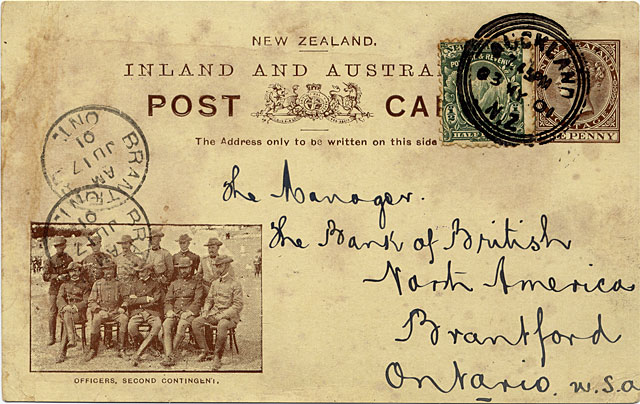
Officers, Second Contingent
New Zealand
Inland and Australia Post Card
Sent from the Bank of Australasia, May 25, 1901 in Auckland New Zealand to The Manager, The Bank of British North America, Brantford, Ontario with Brantford CDS cancel dated July 17, 1901 and Auckland triple ring cancel.
Published in New Zealand Government, part of a Boer War illustrated postal stationery series Card is uprated with a New Zealand half pence stamp.
A set of 16 views was issued March 31, 1900, by the government of New Zealand, on yellow, cream and buff papers.
According to New Zealand History Online, New Zealand “Premier Richard Seddon made the offer of troops the Britain in late 1899, two weeks before conflict finally broke out. Hundreds of men applied to serve, and by the time war began on 11 October 1899, the first contingent were already preparing for departure. Within a few months, they would be engaging the Boers.
By the time peace was concluded two and a half year later, ten contingents of volunteers, totalling nearly 6,500 men with 8,000 horses had sailed for Africa, along with doctors, nurses, veterinary surgeons and a small number of school teachers. Seventy New Zealanders died in the war as the result of action, with another 158 killed accidentally or dying by disease.”

Above, a detail from the postcard
Below, the uprated stamp

Soldiers of the Queen
1899 1900
What We Have We’ll Hold
Canadian Contingent
South African War
Registered for Canada, Jan. 17, 1900
Sam J. Richey , St. John, N. B.
The cover, used by Private David M. McKibbin, a 2nd Contingent, ’A’ Squadron, CMR (Canadian Mounted Rifles) soldier from Capetown to his mother, Mrs. M.E. McKibbin of 135 Huron Street, Stratford, Ontario on April 10, 1900, was marked as postage due. This cover was part of the late William G. Robinson’s collection. In his exhibit, Robinson wrote that Private McKibbin “enlisted in the Royal Canadian Dragoons from the Governor General’s Bodyguard, and was awarded the Queen’s South African Medal with Orange Free State and Cape Colony Clasps.
This Battalion was camped at Stellenbosch, near Capetown, from April 4 to 10, 1900. This letter received the G.P.O. Capetown circular date stamp at 12:30 P.M. on April 10, 1900”. He also writes “Note the Contingent Stationery and the unused space for the Officer Commanding’s signature”.
Click on the image above to be directed to additional examples
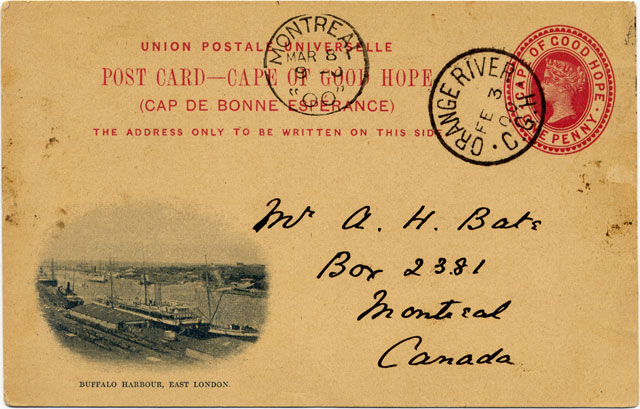
This Cape of Good Hope 1d postal stationery card showing Buffalo Harbour, East London, is a contemporary to the J.C. Wilson Boer War series, and was itself used during the Boer War.
The card was written by Cpl. G. Downey, “E” Coy, 2nd Bn., Royal Canadian Regiment of Infantry, at Belmont on January 30, 1900, ten days after facing a court martial, and mailed at Orange River through the civilian postal system prior to the arrival of the Canadian Postal Unit on February 16, 1900. It was mailed from Orange River C.G.H. to Montreal on February 3, 1900, arriving in Montreal on March 8, 1900.
The postcard back is shown below.
Corporal Downey writes ”...still here at Belmont” after waiting 2 months to see action in the war.
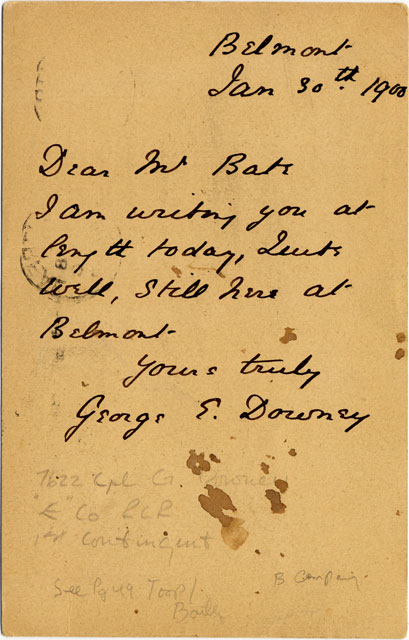
Corporal George E. Downey enlisted in Montreal on October 21, 1899 at the age of 26. He had regimental number 7622.
The 1st Contingent arrived in Cape Town, South Africa aboard the Sardinian on November 29, 1899. The next day the Canadian troops boarded trains for forty hours on a train to Belmont, where they remained camped for two months fighting boredom, disease, and sometimes each other. According to the Canadian Military Page “Insubordination, theft of food, drunkenness, and sleeping on guard duty saw a large number of the men court martialled, and punished in various ways.”
The Canadian Contingent ended their stay in Belmont on February 8, 1900, “when the British commander in chief, Lord Frederick Roberts, announced they would be joining his march to Bloemfontein, the capital of the Orange Free State”.
Downey was brought as a prisoner before a Regimental Court Martial on January 20, 1900 at Belmont. He was charged with three charges, and after pleading guilty to the first charge, had the other charges dismissed. He plead guilty to “Conduct to the prejudice of good order and military discipline, in that he, on the 17th day of January at Belmont, created a disturbance in the camp lines.” Witnesses reported Downey struck and knocked down twice Ln. Capt. Frawley after calling him names. Witnesses for Downey denied such conduct. In the end, after pleading guilty, Downey was sentenced to a severe reprimand.
Corporal Downey returned to Canada with The Queen’s Medal with 3 clasps: Paardeberg, Dreifontein, and Cape Colony. Downey later asked the he be granted the clasp for the Orange River Colony as well. Cpl. Downey was invalided with enteric fever when he was discharged September 25, 1900 in Quebec.
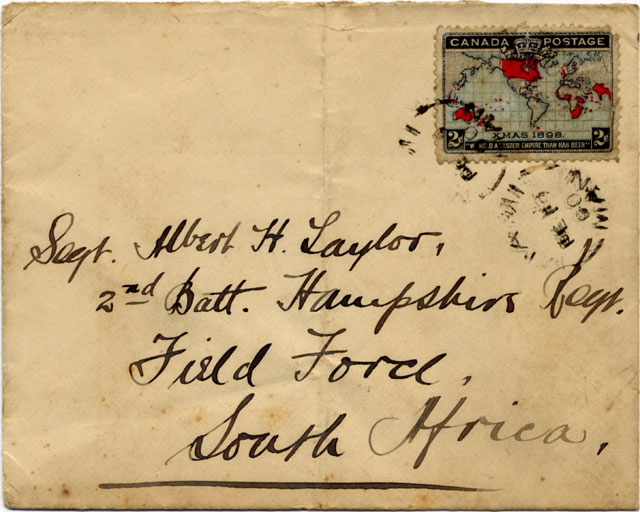
This cover is a contemporary to the J.C. Wilson Boer War series, and was itself mailed during the Boer War from Miami, Manitoba to Segt. Albert H. Taylor, 2nd Batt. Hampshire Regt., Field Force, South Africa on February 19, 1900. The back of the cover is blank.
The 2nd Battalion, Hampshire Regiment sailed aboard the Assaye (7,370 tons) from Southampton, England with 2,025 officers and men about January 4th, 1900, left Las Palmas on January 9th, and arrived at the Cape about January 23rd. According to AngloBoerWar.com, along with the 2nd Norfolk Regiment, 1st KOSB, and 2nd Lincolns, they formed the 14th Brigade under Brigadier General Chermside, and part of the VIIth Division commanded by Lieutenant General Tucker.
From The Hugh Westgate Map Stamp Collection.
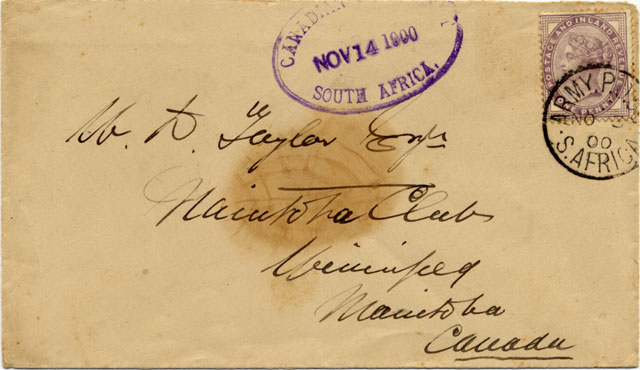
This cover was mailed during the Boer War from South Africa to Mr. A. Taylor Esq., Manitoba Club, Winnipeg, Manitoba. It bears a 1p lilac British stamp no. 89, franked by an Army Post Office cancellation 55 (or 53) dated November 3, 1900, and has a Canadian Contingent violet cachet applied at Base post office in Cape Town dated November 14, 1900. The back of the cover bears a Winnipeg cancel dated December 17, 1900.

According to the Manitoba Historical Society, “the Manitoba Club was founded on 16 July 1874 at a meeting held at the St. James restaurant in Winnipeg. Attending the meeting were several prominent Manitoba businessman: A. G. B. Bannatyne, Henry T. Champion, W. Gouin, Gilbert McMicken, J. A. N. Provencher, C. W. Radiger, Joseph Royal, W. Osborne Smith, Major Taschereau, and W. B. Taylor. The Club was the first of its kind in western Canada”.
From The Hugh Westgate Map Stamp Collection.

This cover has been used from the Boer War to Canada, sent by Sgt. James Hugh Ramage, regimental number 7304. Sgt. Ramage, single, enlisted October 21, 1899, in Toronto, at the age of 24, ten days before the First Contingent set sail from Quebec City. Born in Scotland, but a resident of Port Credit, he was a member of the 36th Peel Battalion when he enlisted. On September 14, 1866 the 36th Peel Battalion was authorized. The regiment, as a unit, did not go to the Boer War although many officers and men from the regiment served there. When Sgt. Ramage enlisted to serve in the Boer War, he joined “C” Company of the 2nd Special Services Battalion R.C.R.
Sgt. Ramage was discharged November 5, 1900, and disembarked from Cape Town on November 30th. He was awarded the Queen’s Medal with 4 clasps: Paardenberg, Dreifontein, Johannesburg & Cape Colony.
The cover bears a FPO 1 cancel dated January 9, 1900, and a London paid cancel dated February 2, 1900, after initially being marked short paid. It was annotated by Sgt. Ramage with “On Active Service” and “No stamps available”, as well “No. 7304, J.H.R.” It is addressed to Captain F.J. Hamilton, Port Credit, Ontario, Canada”. In 1900, Capt. F.J. Hamilton led the 2nd Company of the 36th Peel Battalion. The 2nd Company was based in Port Credit.
The cover itself is scarce, bearing the text “Canadian Contingent 1899 - 1900” and the maple leaf. William G. Robinson displayed a copy of this Canadian Contingent stationery in his collection, noting it was used during late 1899 and 1900. Stephen G. Rich notes the existence of this stationery, and states, in his book Philately of the Anglo-Boer War 1899 - 1902 “The earliest use I have seen is Jan 17, 1900, with a double circle Field Post Office (not B.O.) No. 1. This office was at De Aar, Cape Colony at this period. The type with the Maple Leaf on the flap is probably among the scarcest of the Canadian Contingent covers. Evidently only a small supply was made and used, and apparently few have been preserved.” With more copies becoming known in the years between Rich (1943) & Rowe’s (1981) books’ publication, Kenneth Rowe rates this stationery as 3 out of 10 on his rarity scale (with 10 being most rare).
Below, reverse of the cover

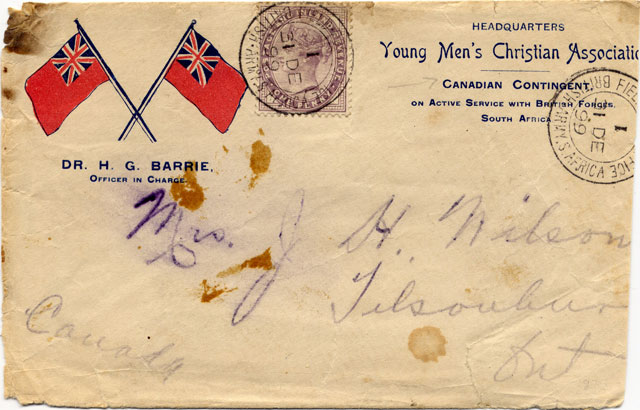
This YMCA Canadian Contingent patriotic cover was used during the Boer War. The text on the cover reads:
Dr. H.G. Barrie
Officer in Charge
Headquarters
Young Men’s Christian Association
Canadian Contingent
On Active Service With British Forces,
South Africa
The cover was part of the late Wm. G. Robinson’s Boer War Collection. It does not appear in the first edition of his exhibit entitled “Canadian Participation in the Anglo-Boer War, 1899–1902”, published by the British North America Philatelic Society Ltd. as BNAPS Exhibit No. 1 in September 1996, however, it appears in the revised 2nd edition dated January 2011. Robinson lists the cover as a 1st Contingent cover, and describes the cover as follows:
“From #8005, Pte. J.H. Wilson, to Tilsonburg, Ontario. Field P.O. 1, De Aar, Dec. 31, 1899, b/s Hamilton, Feb. 5, 1900”
The cover back is shown below, showing the Hamilton, Ontario back stamp.

Kenneth Rowe, in his book “The Postal History of the Canadian Contingents, Anglo-Boer War, 1899–1902” describes the cover as a Type “D”, and notes its first use being in December of 1899, making this an example of an early use of the cover. Rowe notes the cover design was used until May of 1900, and was printed in South Africa.

This YMCA Canadian Contingent patriotic cover is a contemporary to the J.C. Wilson Boer War series, and was itself used during the Boer War. The text on the cover reads:
Headquarters
Young Men’s Christian Association
Canadian Contingent
On Active Service With British Forces,
South Africa
The cover was part of Wm. G. Robinson’s Boer War Collection. In the first edition of his exhibit entitled “Canadian Participation in the Anglo-Boer War, 1899–1902”, published by the British North America Philatelic Society Ltd. as BNAPS Exhibit No. 1 in September 1996, Robinson describes the cover as follows:
“This cover showing a Y.W.C.A. corner card (Rowe Type E) mailed at Field Post Office No. 1 at Orange River, to Hamilton, Ont. on 28 January 1900, by a member of the Royal Canadian Regiment.
It has no stamp, and shows a 1d/F.B. London postage due marking, and a large 2 Canadian marking which was crossed out. It is endorsed with ‘Via New York’, and there is no arrival mark.
This is an early use of this Y.M.C.A. stationery, which Rowe lists in February, 1900.”
In the second edition of his exhibit publication, Robinson adds that the “Via New York” endorsement is for winter sailing, and that the cover was from a member of “C” Coy, Belmont Station.
On February 24, 1900, a Post Office Department circular was issued stating that letters sent from South Africa by Canadian troops on which postage was unpaid or insufficiently paid would be delivered to the addresses without collection of deficient postage. It is likely that the date on which this cover was delivered to Hamilton was just past the time that this new regulation came into effect, hence leading to the scratching out of the 2¢ short paid postage marking.
The cover back is shown below, with a pencil notation referring to a price of $275 in June of 1994 from Alan Steinhart.

When examining the handwritten text on the front of the cover, it can be seen that some additional text can be read. The handwriting also notes “Stamps Unavailable” and portions of the address not obscured by the postal markings show the recipient might be “Miss Jean Goxxrpsan, 174 Stxxoxxx St, Hamilton Canada”” where x’s are unrecognizable text.


This YMCA Canadian Contingent patriotic cover is a contemporary to the J.C. Wilson Boer War series, and was itself used during the Boer War. The text on the cover reads:
The Work of the
Young Men’s Christian Association
With the Canadian Contingent in South Africa
Thomas F. Best, Officer in Charge.
Home Office, 421 Yonge St., Toronto
The cover was part of Stephen G. Rich’s Boer War Collection. In his book Philately of the Anglo-Boer War, 1899-1902, Rich shows the cover as illustration 8-3. He notes:
“Cachet Oct. 24, 1900, double circle Field Post Office 21, October 23, 1900, place unlocated. 1d Great Britain stamp—on a different Y.M.C.A. patriotic envelope with a large Canadian Flag in red and blue”.
The cover was mailed to Mr. D.H. Price, Aylmer West, Ontario, Canada, and has a backstamp from Aylmer (West) dated November 19, 1900, taking almost a month in transit.
In Kenneth Rowe’s book, The Postal History of the Canadian Contingents 1899-1902, he designates this example of Y.M.C.A. stationery as Type G. which he notes as in use from April to October of 1900, making this a late use of this cover design.
The cover back is shown below.
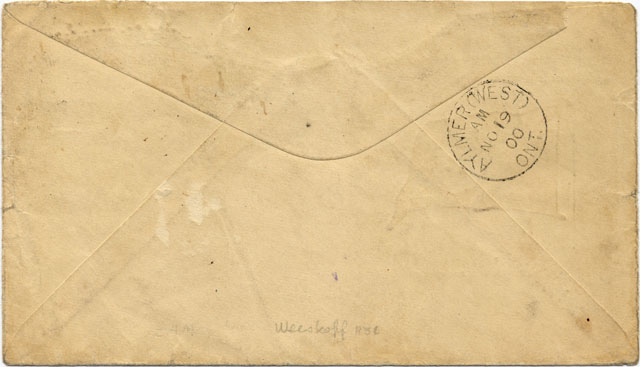

This Boer War usage of a patriotic cover with a printed Union Jack flag and the text “Rule Britannia!” on the front, is a contemporary to the J.C. Wilson patriotics. It has been mailed from the war, with a Field Post cancellation over a Cape of Good Hope 1 penny stamp, a 1 penny V.R.I. overprinted Transvaal stamp, no. 215, (issued under British military authority in 1900), and a British 1 penny QV stamp, no. 89.
The stamps have also been cancelled with the sender’s name, Norman Thomas Lloyd, who forwarded the cover to Frederick A. Lloyd of Cambridge, Massachusetts, USA. Norman Thomas Lloyd enlisted with the Royal Irish Rifles in Halifax, N.S. in 1886 and served with them for 21 years, including his service in the Boer War.
In the summer of 1900 the Royal Irish Rifles were part of the garrison of Bloemfontein, until the beginning of September when they temporarily joined in the relief of Ladybrand. In the fall of 1900, two companies operated in the south-east of the Orange River Colony.
In 1908 Norman Thomas Lloyd joined the 63rd Halifax Rifles and was chosen to represent the regiment at King George V coronation. He served as a drill instructor during WW1, and died December 6, 1941.

This cover was mailed during the Boer War, but from the former Orange Free State after it was occupied and annexed as part of the British Empire on May 24, 1900. The cover was mailed from Winburg, Orange River Colony, under British occupation, on Aug 23, 1901 to John Boyer, Esq., Kincardine, Ontario. It bears a pair of Scott 45 stamps, with the Orange Free State 1894 1p issue surcharged with V.R.I. (for Victoria Queen-Empress in Latin) & 1d.
The cover was likely sent by Ira P. Boyer, A.S.C., Winburg O.R.C., as a second cover in the same handwriting dated January 16, and a third dated May 22, 1902, to Mrs. John Boyer has also been seen. A.S.C. stood for Army Service Corps, which was a British designation for a body charged with military transport. The Canadian Army Service Corps, the supply service established by the Canadian military out of Canadian military shortcomings in the Boer War in planning and supply, was not formed until 1903.
The cover also shows a pair of censor markings: the blue NPR which was used in Bloemfontein from April to October of 1901, (the cover bears a transit from Bloemfontein dated August 24 on the reverse) and a double triangle “Passed Press Censor” marking with ink initials “I.I.D.C Capt.” and the date 23.8.01. The reverse also shows a wax seal initialled IPB and dated by the sender on August 22nd, a Hamilton transit on September 22nd, and a Kincardine receiver dated September 23, 1901.
Below, the reverse of the cover.


A series of postcards have been added that were printed by H.M. Guest, Printer, Klerksdorp on the subject of the Anglo-Boer War, 1899, 1900-01, printed in December 1901. These cards were mailed the same day, May 9, 1902 bearing an Army Field Post cancel to Miss Tremayne, Mimico, Ontario, where they were received on June 14, 1902. Below, a card back, and faces of the other three cards.
These cards were likely sent by Capt. Henry Ernest Tremayne, Regimental No. 3417, of the 10th Canadian Field Hospital. Ernest Tremayne was a doctor, aged 28, at the time the postcards were sent, likely to his 9 year old niece, Hellen, who lived with her parents, and where Ernest also lived, as listed in the 1901 census, with his brother’s family and their servant.





Royal Review
This OHMS cover, postmarked October 11, 1901 at the Toronto Army Post Office, was on the occasion of the Royal Review at Exhibition Park Camp. It was addressed to L.H Irving, Esq., “Overbrook”, Mineral Springs, Ont. via T.H.&B. Ry.
The tour in 1901 by the Duke & Duchess of Cornwall and York included South Africa, Australia, New Zealand, Canada, and the Colony of Newfoundland. Its primary goal was to reward the dominions for their participation in the South African War of 1899–1902.
While in Canada, the Duke presented newly minted South African War medals to veterans of the Boer War in a Royal Review ceremony in Toronto on October 11, 1901. The Canadian leg of the tour started in Quebec on September 16th, and also included Halifax, before departing from Newfoundland.
Below, an image of Adelaide Street in Toronto decorated up for the Royal Visit.


Victoria One Penny Postal Stationery Reply Card
Card has had photograph of Australian troops marching through downtown Melbourne related to the Boer War pasted onto the front of the card. Postmarked Melbourne July 30, 1901, with the annotation Australians, S. African War. It is possible the photo might date to the tour in 1901 by the Duke & Duchess of Cornwall and York, which occurred in Australia in May, 1901. They sailed to Melbourne, where the Duke opened the first Australian federal parliament.
Below, an enlargement of a portion of the photograph on the card.
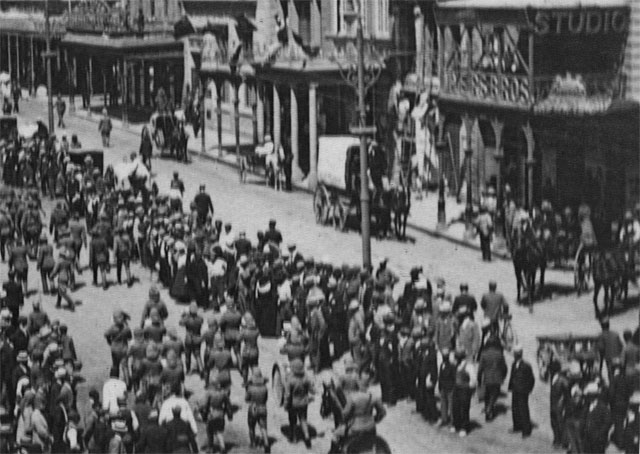

Union Postale Universelle
Post Card
Natal
Subject to Letter Rates
Stamps Unavailable During This Siege
Address Only to be Written On This Side
This card was mailed from Durban, Natal on September 27. 1901 to Toronto, with a 1 penny Natal stamp, at the soldier’s rate.
Below, the reverse of the card.

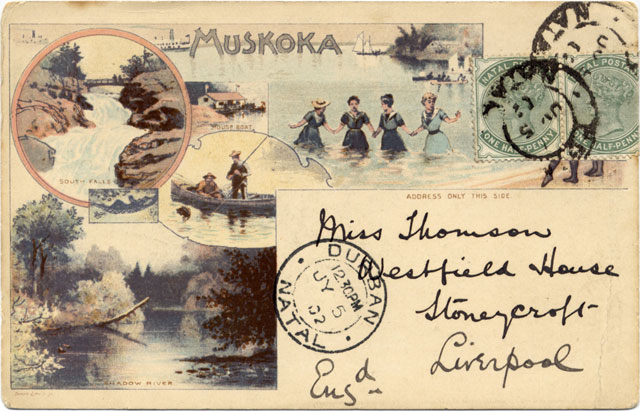
Muskoka
Toronto Lithographing Co. Limited
Shadow River, South Falls, House Boat
Early card with blank back and stamp box on front.
This very unusual use of a Toronto Litho Co. Canadian Cities Series postcard with vignettes of Muskoka has been mailed from Natal to Liverpool, England shortly after the end of the Boer War. Bearing a Durban cancellation dated July 5, 1902 on a pair of ½ penny Natal stamps, the card was mailed to Miss Thomson, Westfield House, Stonecroft, Liverpool, England.
The Boer War had ended on May 31st, and the return of foreign troops to their homelands was underway at this time. The card may have been sent from a Canadian soldier waiting to embark on his homeward journey. The Winifredian had left Port Natal June 27 bound for Halifax. Durban was the busiest port in South Africa, and Port Natal was the jumping off point for many of the returning troops.


Winnipeg
Toronto Lithographing Co. Limited
City Hall, Main Street, Parliament Buildings
Early card with blank back and stamp box on front.
This second very unusual use of a Toronto Litho Co. Canadian Cities Series postcard with vignettes of Winnipeh has been mailed from Natal to Liverpool, England shortly after the end of the Boer War. Bearing a Durban cancellation dated July 5, 1902 on a pair of ½ penny Natal stamps, the card was mailed to Miss Thomson, Westfield House, Stonecroft, Liverpool, England. This has been sent by the same sender to the same receiver as the Toronto Litho Muskoka postcard.
The Boer War had ended on May 31st, and the return of foreign troops to their homelands was underway at this time. The card may have been sent from a Canadian soldier waiting to embark on his homeward journey. The Winifredian had left Port Natal June 27 bound for Halifax. Durban was the busiest port in South Africa, and Port Natal was the jumping off point for many of the returning troops.


Boer War-era handkerchief
“The Soldiers of the Queen
Written & Composed By Leslie Stuart
Sung By Albert Christian
Reproduced by Permission of the Publishers of the Song
Francis Day & Hunter
142 Charing Cross London
+ R. March & Co. Song Publishers London EC”

It’s the soldiers of the Queen my lads, Who’ve been my lads Who’ve seen my lads, In the fight for Eng-lands glo-ry, lads, When we’ve had to show them what we mean, And when we say we’ve al-ways won. And when they ask us how it’s done Well proud-ly point to ev-ery one of England’s sol-diers of the Queen It’s the Queen!

Some examples of patriotic postcards, contemporary to J.C. Wilson patriotics, published by the The Patriotic Pictorial Postcard Co. of London, England, with Boer War subject matter, are shown in a separate collection. While British in origin, they are occasionally found with usage within Canada (see typical back used in Canada, below)
Each card bears several bars of music and the lyrics of popular patriotic songs from the Anglo-Boer War era. The cards are identified below by their patriotic song series.
